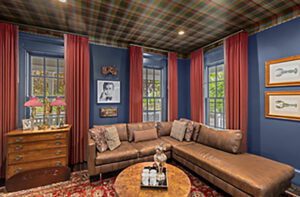Painter Matthew Chamberlain
July 14, 2020
Text by Marni Elyse Katz
In April, Matthew Chamberlain ventured to the basement of his Portland, Maine, apartment building to rummage through forgotten piles of junk. The forty-two-year-old Maine College of Art graduate had run out of
canvases. Art supply stores were shuttered, and shipping costs for large canvases were prohibitively pricey, so he had to improvise. “I remembered seeing a stack of doors down there that I thought I could paint on,” says the artist. “I’m doing these things a favor by giving them a new life.”
Chamberlain has insight on rebirths. A couple of years ago, he sold his catering business in order to paint full time. Now he’s working on a collection of ten six-foot-by-seven-foot-eight-inch pieces for a solo show at Portland’s Press Hotel titled Good ’n’ You. The aforementioned doors are part of the series. “At first I was afraid it was too Rauschenberg but decided that wasn’t a bad thing,” he says. The piece, which is a diptych, also includes his own quilted baby blanket that he persuaded his mom to sacrifice and pages from an
old fishing boat manual that he got from a friend.
Despite interesting backstories, the elements that Chamberlain incorporates into his work carry little, if any, significance beyond aesthetic appeal. “My work has never been about anything; it’s like Seinfeld,” he says, referencing the sitcom famous for being about nothing. There’s no grand idea or central concrete narrative. Chamberlain explains, “They simply convey my love for making, as well as my love for history and found objects.”
Chamberlain describes his process as “reactionary.” He starts by making a mark on a blank canvas, then sees where it takes him. Along with found objects, he uses acrylic and oil paints, as well as spray paint, old house paint, and resin. If it weathers weirdly, all the better. “I pour one material on top of another material,” he says. “It might crackle or peel, then I react to that. I might scratch the paint off.”
In addition, Chamberlain notes that he’s careful not to treat his paintings as though they’re precious. He finds satisfaction in serendipity. “I hope for happy accidents,” he says. “A lot of times, I let the painting make itself.”
Share
![NEH-Logo_Black[1] NEH-Logo_Black[1]](https://b2915716.smushcdn.com/2915716/wp-content/uploads/2022/08/NEH-Logo_Black1-300x162.jpg?lossy=1&strip=1&webp=1)













You must be logged in to post a comment.